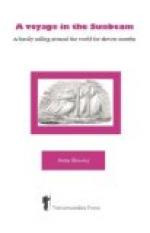Then one might go southward from Jaffna, past Aripo, and the Gulf of Calpentyn, until the curious reef of Adam’s Bridge was reached, which almost connects Ceylon with India. People say it has been separated by some convulsion of nature in former days, and that the passage is gradually deepening; but recent examinations have shown that instead of being a remnant of the original rock by which Ceylon is supposed to have been once connected with the Indian continent, it is in reality a comparatively recent ridge of conglomerate and ironstone, covered with alluvial deposits carried by the current and heaped up at this particular point; whilst the gradual rising of the coast has contributed to give the reef its present altitude.
Balchus tells a most improbable story of fifteen Portuguese frigates escaping through the passage of Panupam, when pursued by some Dutch cruisers in 1557. Formerly the Straits were only thirty-five yards wide, with a maximum depth of six feet of water, but lately they have been widened and deepened by ten feet, and a little Government steamer frequently passes through on a tour round the island. At present a sailing ship going from Bombay to Madras has to make a curve of five thousand miles in order to weather the Maldives and Ceylon. It seems a long course for any vessel drawing over ten feet of water to be obliged to take.
In the centre of the channel there is a little island where a Dutch establishment for horse-breeding formerly stood, the original stud having been imported from Arabia. The horses were all turned into corrals and caught by means of lassos, and then conquered by domidores, exactly as they are at the present day in South America. Now the stud is dispersed, the buildings are in ruins, and all that remains is the Indian pagoda, where religious ceremonies, curious processions, and dances of nautch-girls occasionally take place and are attended by great crowds. To the southward again of Adam’s Bridge is the celebrated Gulf of Manaar, from which the best pearls come.
This is an exceptionally good year for pearls, and the price of the shells went up many rupees per thousand in the first week. The pearl fishery can be reached in about eight hours by steam from Colombo, and it would have been delightful to have visited it, had time permitted. We were shown an oyster with some beautiful pearls in it, all found in the one shell. When a boat with pearls reaches the shore, the shells are divided into equal heaps, one-fourth going to the boat’s crew, and three-fourths to the Government Inspector. They keep whichever heap he chooses to kick; so that, being uncertain which they will get for themselves, the boat’s crew are sure to make a fair division. These heaps are then divided and sold by auction in thousands, and then subdivided again and again. Of course it is always a matter of speculation as to whether you get good pearls, bad pearls, or no pearls at all, though this last misfortune seldom happens.




